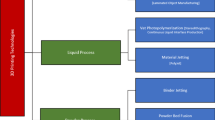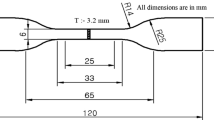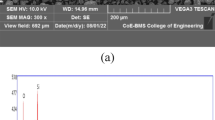Abstract
The quality of 3D printed thermoplastic structures mainly depends upon the various aspects of deposition pattern, processing conditions, and layer bonding. The incomplete layer-to-layer adhesion during the additive manufacturing process is the most critical issue since thermoplastics are bad heat conductors. In this study, aluminum (Al) microfilms have been deposited to promote the adhesion between the additive layers. The composite structures (as per ASTM D 695) of polylactic acid thermoplastic were manufactured by fused filament fabrication (FFF) process and consecutively reinforced with Al spray. The composite structures were subjected to compressive loading to investigate the influence of input process variables like; in-between microfilm layers (1–5 layers), bed temperature (60–100 °C), and infill percentage (40–100%). The results of the study suggested that using microfilm in-between additive layers is a promising technique for improving the compressive properties. The compressive strength has been observed maximum by performing FFF with 3 layers of Al microfilm, 70% of infill percentage, and 100 °C bed temperature. The results are supported by scanning electron microscopy, energy-dispersive spectroscopy, and differential scanning calorimeter analysis. An optimization study was successfully conducted using the analytic hierarchy process, which predicted the optimum parameter settings based on the relative importance of each response variable.








Similar content being viewed by others
References
Attaran M (2017) The rise of 3-D printing: the advantages of additive manufacturing over traditional manufacturing. Bus Horiz 60(5):677–688
Mathias D, Snider C, Hicks B, Ranscombe C (2019) Accelerating product prototyping through hybrid methods: coupling 3D printing and LEGO. Des Stud 62:68–99
Singh S, Prakash C, Ramakrishna S (2019) 3D printing of polyether-ether-ketone for biomedical applications. Eur Polym J 114:234–248
Tilford T, Stoyanov S, Braun J, Janhsen JC, Burgard M, Birch R, Bailey C (2018) Design, manufacture and test for reliable 3D printed electronics packaging. Microelectron Reliab 85:109–117
Ordoñez E, Gallego JM, Colorado HA (2019) 3D printing via the direct ink writing technique of ceramic pastes from typical formulations used in traditional ceramics industry. Appl Clay Sci 182:105285
Ford S, Minshall T (2019) Invited review article: where and how 3D printing is used in teaching and education. Addit Manuf 25:131–150
Liu Z, Lei Q, Xing S (2019) Mechanical characteristics of wood, ceramic, metal and carbon fiber-based PLA composites fabricated by FDM. J Mater Res Technol 8(5):3741–3751
Li M, Chen AN, Lin X, Wu JM, Chen S, Cheng LJ et al (2019) Lightweight mullite ceramics with controlled porosity and enhanced properties prepared by SLS using mechanical mixed FAHSs/polyamide12 composites. Ceram Int 45(16):20803–20809
Krinitcyn M, Fu Z, Harris J, Kostikov K, Pribytkov GA, Greil P, Travitzky N (2017) Laminated object manufacturing of in situ synthesized MAX-phase composites. Ceram Int 43(12):9241–9245
ASTM (2012) Standard terminology for additive manufacturing technologies. ASTM International F2792-12a, West Conshohocken
Lay M, Thajudin NLN, Hamid ZAA, Rusli A, Abdullah MK, Shuib RK (2019) Comparison of physical and mechanical properties of PLA, ABS and nylon 6 fabricated using fused deposition modeling and injection molding. Compos B Eng 176:107341
Ni J, Ling H, Zhang S, Wang Z, Peng Z, Benyshek C et al (2019) Three-dimensional printing of metals for biomedical applications. Mater Today Bio 3:100024
Valino AD, Dizon JRC, Espera AH Jr, Chen Q, Messman J, Advincula RC (2019) Advances in 3D printing of thermoplastic polymer composites and nanocomposites. Prog Polym Sci 98:101162
Henke K, Treml S (2013) Wood based bulk material in 3D printing processes for applications in construction. Eur J Wood Wood Prod 71(1):139–141
Chen Z, Li Z, Li J, Liu C, Lao C, Fu Y et al (2019) 3D printing of ceramics: a review. J Eur Ceram Soc 39(4):661–687
Hassan M, Dave K, Chandrawati R, Dehghani F, Gomes VG (2019) 3D printing of biopolymer nanocomposites for tissue engineering: nanomaterials, processing and structure–function relation. Eur Polym J 121:109340
Dankar I, Haddarah A, Omar FE, Sepulcre F, Pujolà M (2018) 3D printing technology: the new era for food customization and elaboration. Trends Food Sci Technol 75:231–242
Singh R, Singh N, Fabbrocino F, Fraternali F, Ahuja IPS (2016) Waste management by recycling of polymers with reinforcement of metal powder. Compos B Eng 105:23–29
Kim DY, Kim JH, Kim HY, Kim WC (2018) Comparison and evaluation of marginal and internal gaps in cobalt–chromium alloy copings fabricated using subtractive and additive manufacturing. J Prosthodont Res 62(1):56–64
Patton MV, Ryan P, Calascione T, Fischer N, Morgenstern A, Stenger N, Nelson-Cheeseman BB (2019) Manipulating magnetic anisotropy in fused filament fabricated parts via macroscopic shape, mesoscopic infill orientation, and infill percentage. Addit Manuf 27:482–488
Wan L, Zhang Y (2018) Jointly modified mechanical properties and accelerated hydrolytic degradation of PLA by interface reinforcement of PLA-WF. J Mech Behav Biomed Mater 88:223–230
Nonato RC, Mei LHI, Bonse BC, Chinaglia EF, Morales AR (2019) Nanocomposites of PLA containing ZnO nanofibers made by solvent cast 3D printing: production and characterization. Eur Polym J 114:271–278
Alam F, Shukla VR, Varadarajan KM, Kumar S (2020) Microarchitected 3D printed polylactic acid (PLA) nanocomposite scaffolds for biomedical applications. J Mech Behav Biomed Mater 103:103576
Ye W, Lin G, Wu W, Geng P, Hu X, Gao Z, Zhao J (2019) Separated 3D printing of continuous carbon fiber reinforced thermoplastic polyimide. Compos A Appl Sci Manuf 121:457–464
Dong J, Huang X, Muley P, Wu T, Barekati-Goudarzi M, Tang Z et al (2020) Carbonized cellulose nanofibers as dielectric heat sources for microwave annealing 3D printed PLA composite. Compos B Eng 184:107640
Sezer HK, Eren O (2019) FDM 3D printing of MWCNT re-inforced ABS nano-composite parts with enhanced mechanical and electrical properties. J Manuf Process 37:339–347
Kumar S, Singh R, Singh TP, Batish A (2020) Investigations for mechanical, thermal and magnetic properties of polymeric composite matrix for four-dimensional printing applications. J Braz Soc Mech Sci Eng 42(4):1–15
Francis V, Jain PK (2018) A filament modification approach for in situ ABS/OMMT nanocomposite development in extrusion-based 3D printing. J Braz Soc Mech Sci Eng 40(7):361
Monteiro JRL, d’Almeida JRM (2018) Evaluation of the mechanical performance of the creep behavior of a fiberglass repair after aging in oil. J Braz Soc Mech Sci Eng 40(7):346
Standard ASTM (2014) D638-14. Standard test method for tensile properties of plastics. https://www.astm.org/Standards/D638. Retrieved on 18 Aug 2020
Wurth India Ltd. https://eshop.wuerth.in/Perfect-aluminium-spray-matt-ALUSPR-PLUS-400ML/0893114115.sku/en/US/INR/. Retrieved on 15 May 2020
Spoerk M, Gonzalez-Gutierrez J, Sapkota J, Schuschnigg S, Holzer C (2018) Effect of the printing bed temperature on the adhesion of parts produced by fused filament fabrication. Plast Rubber Compos 47(1):17–24
Chadha A, Ul Haq MI, Raina A, Singh RR, Penumarti NB, Bishnoi MS (2019) Effect of fused deposition modelling process parameters on mechanical properties of 3D printed parts. World J Eng 16(4):550–559. https://doi.org/10.1108/WJE-09-2018-0329
Hwang CL, Yoon K (1981) Multiple attribute decision making: methods and applications. Springer, New York. https://doi.org/10.1007/978-3-642-48318-9
Shih HS, Shyur HJ, Lee ES (2007) An extension of TOPSIS for group decision making. Math Comput Model 45(7–8):801–813
Lan TS (2009) Taguchi optimization of multi-objective CNC machining using TOPSIS. Inf Technol J 8(6):917–922
Singh A, Datta S, Mahapatra SS (2011) Application of TOPSIS in the Taguchi method for optimal machining parameter selection. J Manuf Sci Prod 11(1–3):49–60
Balasubramaniyan S, Selvaraj T (2017) Application of integrated Taguchi and TOPSIS method for optimization of process parameters for dimensional accuracy in turning of EN25 steel. J Chin Inst Eng 40(4):267–274
Şimşek B, İç YT, Şimşek EH (2013) A TOPSIS-based Taguchi optimization to determine optimal mixture proportions of the high strength self-compacting concrete. Chemometr Intell Lab Syst 125:18–32
Yuvaraj N, Pradeep Kumar M (2015) Multiresponse optimization of abrasive water jet cutting process parameters using TOPSIS approach. Mater Manuf Process 30(7):882–889
Khatwani J, Srivastava V (2019) Effect of process parameters on mechanical properties of solidified PLA parts fabricated by 3D printing process. In: Kumar L, Pandey P, Wimpenny D (eds) 3D printing and additive manufacturing technologies. Springer, Singapore. https://doi.org/10.1007/978-981-13-0305-0_9
Torres J, Cotelo J, Karl J, Gordon AP (2015) Mechanical property optimization of FDM PLA in shear with multiple objectives. JOM 67(5):1183–1193
Acknowledgements
The authors are highly thankful to the University Centre for Research and Development (UCRD), Chandigarh University, for providing financial/technical support to carry this research.
Author information
Authors and Affiliations
Corresponding author
Additional information
Technical Editor: Zilda de Castro Silveira.
Publisher's Note
Springer Nature remains neutral with regard to jurisdictional claims in published maps and institutional affiliations.
Rights and permissions
About this article
Cite this article
Kumar, R., Chohan, J.S., Kumar, R. et al. Hybrid fused filament fabrication for manufacturing of Al microfilm reinforced PLA structures. J Braz. Soc. Mech. Sci. Eng. 42, 481 (2020). https://doi.org/10.1007/s40430-020-02566-1
Received:
Accepted:
Published:
DOI: https://doi.org/10.1007/s40430-020-02566-1




